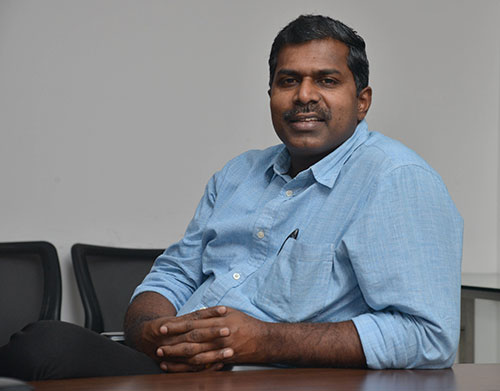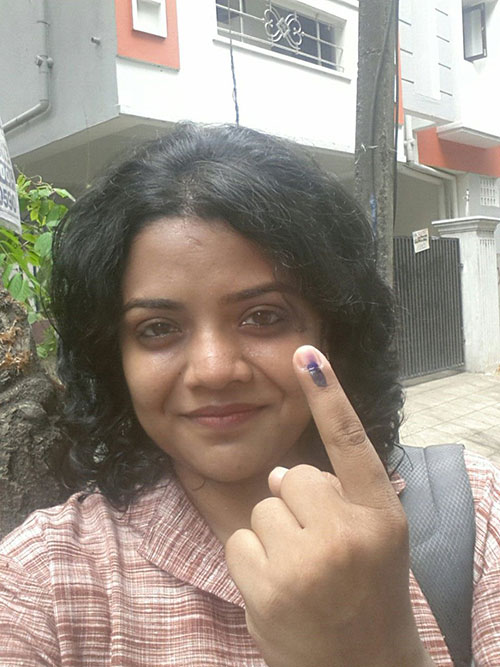May 3 is observed as International Press Freedom Day worldwide. According to a 2019 report released by Reporters Without Borders, India fell by two places to rank 140 out of 180 countries on press freedom index. The current climate in the country for journalists has deteriorated to an unprecedented low where mainstream media, increasingly driven by profits, is censored by political and corporate giants and any dissident report invites threats, abuse – online and offline and attacks. Six journalists have been killed last year– veteran journalist and Rising Kashmir editor Shujaat Bukhari, Dainik Bhaskar journalist Naveen Nischal and another freelance reporter Vijay Singh, Doordarshan cameraperson Achyuta Nanda Sahu, Aaj journalist Chandan Tiwari in Jharkhand and Sandeep Sharma, who was investigating illegal sand mining in Madhya Pradesh’s Bhind district—and another reporter of a local news channel in Manipur, Kishorechandra Wangkhemcha, has been detained for 10 months.
Sruthy Susan Ullas, interviews two award winning senior investigative journalists whose stories have created much flutter in the country and raised bars in reporting and evoked hope among those who believe byline is dying.
Josy Joseph is an award winning Delhi based journalist, who has served as national security editor of The Hindu,  editor-special projects of the Times of India, associate editor of DNA newspaper, apart from Rediff.com, the Asian Age, Delhi Mid Day, and the Blitz. Josy’s investigation stories include the Mumbai Adarsh Housing scam, Leave-Travel Concession scam, and the corruption involved in the run-up to the 2010 Commonwealth Games in New Delhi. He has also authored ‘A Feast of Vultures: The hidden business of democracy in India’ in which he does breakthrough reportage on the flourishing phenomenon of middlemen in India. Jet Airways filed a civil defamation suit of Rs 1,000 crore on his allegations of links between Naresh Goyal, the founder of the airline, and underworld don Dawood Ibrahim in the book. He was conferred India’s best political reporter award in 2010 by the Prem Bhatia Trust and journalist of the year award by Ramnath Goenka Foundation in 2013.
editor-special projects of the Times of India, associate editor of DNA newspaper, apart from Rediff.com, the Asian Age, Delhi Mid Day, and the Blitz. Josy’s investigation stories include the Mumbai Adarsh Housing scam, Leave-Travel Concession scam, and the corruption involved in the run-up to the 2010 Commonwealth Games in New Delhi. He has also authored ‘A Feast of Vultures: The hidden business of democracy in India’ in which he does breakthrough reportage on the flourishing phenomenon of middlemen in India. Jet Airways filed a civil defamation suit of Rs 1,000 crore on his allegations of links between Naresh Goyal, the founder of the airline, and underworld don Dawood Ibrahim in the book. He was conferred India’s best political reporter award in 2010 by the Prem Bhatia Trust and journalist of the year award by Ramnath Goenka Foundation in 2013.
- How would you rate the climate for press freedom in India?
A: After independence, never has our country witnessed such a horrible era of press freedom except for the Emergency. This appalling situation is the result of a host of factors that have been brewing over several years but has been accentuated by Narendra Modi, who is without doubt, the most anti-democratic political leader we have ever had. What Modi has managed to do is to identify the weaknesses of Indian mainstream media and the press the right buttons which have made our media mere lapdogs of political and business giants.
There are several factors. One, most of the mainstream media is run by big business houses whose primary motive is not to do journalism. For instance, Times of India is owned by the largest private equity investors, ETV Media, Network 18, First Post are owned by Mukesh Ambani, Dainik Jagran is owned by a BJP MP. Media is only a ploy or a Trojan horse for big business houses to achieve their other ambitions.
Two, India is the probably the only country were you can buy your newspaper cheaper than your morning cup of tea. The newspapers are heavily subsidised by advertisers.
Three, the rise of TV news in the past two decades have been heavily influenced by our obsession with films and is based on the cheap model of breaking news. We have created a generation of anchors whose journalistic skills are very shallow, to the extent that they have been reduced to court jesters and mere entertainers.
And fourth, we have not created a public institution to nurture good journalism.
The scenario in the small towns and villages are worse. If you write dissenting stories, you get threatened, kidnapped or even killed. The state of media is a larger reflection of the deep crisis our democracy is in today.
- How do you deal with fear?
A: There are two ways of narrating a story. One, you can take the centre stage in the story. Two, which I prefer, is to be a fly on the wall, and not be present in the story. As long as I am not in it, I am low on fear and I am more excited about the next story I have to file. But, I do occasionally take anti-anxiety medicines.
- Do you feel that new Indian digital media outlets like the Wire, the Quint or the Scroll give hope to this situation?
A: The new start-ups provide a platform for those who dissent and give them a voice which mainstream media fails to do. But the craft of journalism they do is not very different from the latter.
- What’s your new project?
A: I resigned from The Hindu in August 2018. I am now involved in establishing an academically rigorous media start up, which we want to call Global, with a strong South Asia focus and its default, deliberate character will be investigative journalism.
- Your message to aspiring journalists.
A: You cannot not blame the youngsters if they don’t do well because they are picking up from a generation where lethargy and nepotism prevails. If you have to be a journalist of global standards, you have to work hard, read more and study more.
Sandhya Ravishanker, editor of The Lede – a consortium of independent journalists from across the five south  Indian states – has been a television news reporter and producer for a decade. She has worked with national channels including CNN News18, Times Now, CNBC-TV18. Sandhya has reported several groundbreaking stories including the illegal beach sand mining expose in Tamil Nadu, which won her the Ramnath Goenka Award for Excellence in Journalism in 2019. Also to her credit is the expose of flawed arithmetic in Jayalalithaa’s acquittal in the Bengaluru High Court in a corruption case.
Indian states – has been a television news reporter and producer for a decade. She has worked with national channels including CNN News18, Times Now, CNBC-TV18. Sandhya has reported several groundbreaking stories including the illegal beach sand mining expose in Tamil Nadu, which won her the Ramnath Goenka Award for Excellence in Journalism in 2019. Also to her credit is the expose of flawed arithmetic in Jayalalithaa’s acquittal in the Bengaluru High Court in a corruption case.
- Your stories on sand mining mafia are the most hard-hitting and what your byline is most associated with now. Can you share the story behind the story.
A: It was an accident, really. What I thought was a small raid by a district collector, became a much bigger story that is potentially the largest ever scam in India that has cost the exchequer hundreds of thousands of crores of losses. And these are real losses, not notional losses like 2G. It started in 2013 when Tutukudi district collector Ashish Kumar raided some sites where there was illegal beach sand mining and I went to cover the story. As I travelled across the southern coast of India, I realised that this was much larger than just a small illegal business. And then began my investigations – it has been over five years now and the story is not over yet.
What prompted me to take it forward over the years is just the reporter’s nose I guess – you find a great story, you know no one else is writing about it, you know there are dangers involved, you know it is in public interest and so you continue to go after the story.
Tracking this story has had a major impact on my life over the past five years – friends turned foes, there was the constant lurking danger to my family and myself, it became difficult to know whom to trust and who was on the payroll of the miners and it became necessary to cultivate habits such as noting down licence plate numbers of vehicles behind you, of memorising faces to see if they follow you. Sometimes it feels like the story does not let you live in peace.
2. You were constantly threatened and abused over several years for your stories. What keeps you going?
A: It may be a bit cliched but I do not like anyone trying to threaten or harass me or my family. I have an innate stubborn streak and when the threats escalate, I only work harder on the story. I realised that if the miners were making such threats, it meant I was doing the right thing, so I simply went ahead.
3. Did the big media houses refuse to carry your story anytime? (Economic Times had once given a rejoinder fearing backlash…)
A: ET did not want to battle a court case, understandably so, and they carried the rejoinder. It is actually a smart rejoinder – if you read it, it takes nothing away from the story, so ET did stand by the piece. I did struggle to get the stories published by mainstream media houses until The Wire and Siddharth Varadarajan put their faith and their spine behind my stories.
4. Have any of your stories never seen the light of the day? If so, what was it?
A: So far so good – all of my stories have been published. I do, of course, have more stories under my belt. They will be published soon in The Lede as soon as I finish the vetting process.
5. What prompted you to start The Lede?
A: I became a freelancer because I could not digest the agenda setting of mainstream media. Freelancing is a very tough thing to do in India. Over a period of time, I wanted to provide a platform for journalists who want to do hard hitting stories from the ground, who don’t want to be worried about whether or not the publication has an agenda. There needs to be a platform that will publish such stories in public interest and have the guts to face lawsuits which may be slapped on us as a result. In south India, we don’t have such a platform and that is the reason The Lede was born.
- India ranks 140 out of 180 in press freedom index. Your comments.
A: I am not surprised. Journalists’ associations themselves have not taken up the cause of press freedom in a major way. Fellow journalists do not stand up for each other, except for some rare gems of people. What is the individual journalist going to do? Especially in districts it is a terrible climate for journalists, especially those who do not wish to toe the line of the powers that be. I am afraid that the journalistic fraternity, with some notable exceptions, is largely self serving and prefers to be on the right side of power rather than stick their neck out to back a fellow journalist.
Posted in International, News




























